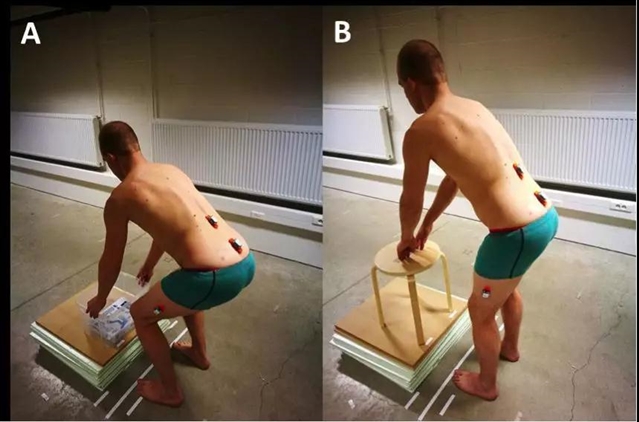|
|
|
|
|
Hold住腰椎动动髋,减缓疼痛的腰背| BMC Journal |
|
|
论文标题:Sensor-based postural feedback is more effective than conventional feedback to improve lumbopelvic movement control in patients with chronic low back pain: a randomised controlled trial
期刊:Journal of NeuroEngineering and Rehabilitation
作者:Thomas Matheve, Simon Brumagne, Christophe Demoulin and Annick Timmermans
发表时间:2018/09/26
数字识别码:10.1186/s12984-018-0423-6
原文链接:https://jneuroengrehab.biomedcentral.com/articles/10.1186/s12984-018-0423-6?utm_source=other&utm_medium=other&utm_content=null&utm_campaign=BSCN_2_DD_BMCJournal_Arti_Scinet
微信链接:https://mp.weixin.qq.com/s/8ZdVyTJUBC3gqRKNOVj1wA
慢性腰背痛患者在进行运动控制练习时,经常会使用镜子来观察自己的动作,然而这种方法或许并不可靠,最近在Journal of NeuroEngineering and Rehabilitation上发表的一项研究中,研究人员探究了无线运动传感器在改善患者运动控制方面的作用,并将其与镜子对比,探讨这种新的方式是否更有效。

您是否经历过腰背痛,即使您没有,您周围也一定有人遭受过腰背痛的折磨。大约80%的人一生中至少会经历一次腰背痛。虽然在大多数情况下,腰背痛会在几周内缓解,但疼痛突发依旧很常见,有些人的症状甚至会发展成慢性腰背痛(即疼痛持续3个月以上)。
慢性腰背痛是一种异质性疾病。对一些人来说,主要是心理社会因素(例如对运动的恐惧)导致了背部疼痛的持续存在,而对另一些人来说,物理因素(疼痛与脊柱的机械负荷密切相关)则更为重要。对于后者来说,腰背疼痛通常是由某些姿势或动作引起的,也可以因相应的姿势或动作缓解。
下面的例子说明了以上第二种情况:Claire抱怨她在保持坐位一小会儿时,提东西时,甚至早晨穿袜子时,都会感觉到腰背痛。经过检查,我们观察到Claire在进行这些活动时总是倾向于过度弯曲腰背部,通过限制腰背部过度弯曲可以缓解她的疼痛。
为了改善Claire的问题,我们可以采用运动控制练习。这些练习的目的是学习如何控制会导致疼痛的运动,从而减少疼痛部位的机械负荷。对Claire而言,这意味着她必须学会少弯曲腰背部,多活动邻近关节,比如髋关节。
当人们学习新的运动技能时,他们有必要了解关于自身表现的反馈,以纠正自己的错误。由于理疗师无法一直在场提供反馈指导,腰痛患者们经常会在镜子前进行锻炼,这样他们就可以观察自身脊柱的动作。然而,如果没有相关经验,通常很难以正确的方式准确评估脊柱的动作。因此,镜子可能并非提供反馈的最有效工具。
通过新技术改善运动反馈
随着康复技术的发展,已经出现了可以提供反馈的新方法。例如可应用无线运动传感器来为患者提供更准确且易于理解的反馈。
那么,现在的问题是,新的基于传感器的反馈与镜像反馈相比,是否能更有效地改善运动控制?我们通过在慢性腰背痛患者中开展了一项随机对照试验来探讨了这一问题。
在基线评估中,参与者执行了两项运动控制任务,并在此期间测量其腰椎(腰背部)和髋关节的活动范围。首先,由参与者完成一项举重任务。要求其在保持腰椎曲度的同时举起一个盒子,即不能弯曲或伸展腰椎(图1A)。此后,由参与者完成鞠躬动作。在这项任务中,参与者站立并保持膝盖微微弯曲,然后按照要求髋部前倾,同时保持腰椎的曲度(图1B)。这些任务均根据参与者的身高进行了标准化。

图1 A:举重任务;B:鞠躬。置于腰背部的运动传感器用于为参与者提供反馈。
图片来自论文
在基线评估后,参与者被随机分为三个亚组。在干预期间,每个小组会收到不同类型的反馈,即来自运动传感器的反馈(图2)、来自镜子的反馈或者无反馈(对照组)。干预包括重复18次的单项练习(3组,每组重复6次),在此期间参与者练习鞠躬动作而不练习举重动作。干预结束后立即重复基线评估。

图2. 基于传感器的反馈可显示在参与者面前的屏幕上。A:绿色矩形位于虚拟化身上半身体内,表示腰部曲度保持不变;B:绿色矩形向前移动到虚拟化身的上半身胸前,表示腰部弯曲。
图片来自论文
我们发现,与镜子组和对照组相比,传感器组参与者的运动控制明显改善。这意味着他们能够更多的弯曲髋关节,而腰椎部位的弯曲程度则减少。
这些改善在鞠躬和举重任务期间均可出现。这表明,传感器组参与者能够将他们从练习过的鞠躬动作中新学到的运动技能转化运用到没有练习过的(举重任务)运动中。
本研究结果表明,基于传感器的反馈具有改善慢性腰背痛患者运动控制能力的潜力。未来的研究应该探究这些改善是否能够长期持续,以及与传统的运动疗法相比,基于传感器反馈的练习能否更大程度地改善疼痛和残疾。
摘要:
Background
Improving movement control can be an important treatment goal for patients with chronic low back pain (CLBP). Although external feedback is essential when learning new movement skills, many aspects of feedback provision in patients with CLBP remain currently unexplored. New rehabilitation technologies, such as movement sensors, are able to provide reliable and accurate feedback. As such, they might be more effective than conventional feedback for improving movement control. The aims of this study were (1) to assess whether sensor-based feedback is more effective to improve lumbopelvic movement control compared to feedback from a mirror or no feedback in patients with chronic low back pain (CLBP), and (2) to evaluate whether patients with CLBP are equally capable of improving lumbopelvic movement control compared to healthy persons.
Methods
Fifty-four healthy participants and 54 patients with chronic non-specific LBP were recruited. Both participant groups were randomised into three subgroups. During a single exercise session, subgroups practised a lumbopelvic movement control task while receiving a different type of feedback, i.e. feedback from movement sensors, from a mirror or no feedback (=control group). Kinematic measurements of the lumbar spine and hip were obtained at baseline, during and immediately after the intervention to evaluate the improvements in movement control on the practised task (assessment of performance) and on a transfer task (assessment of motor learning).
Results
Sensor-based feedback was more effective than feedback from a mirror (p < 0.0001) and no feedback (p < 0.0001) to improve lumbopelvic movement control performance (Sensor vs. Mirror estimated difference 9.9° (95% CI 6.1°-13.7°), Sensor vs. Control estimated difference 10.6° (95% CI 6.8°-14.3°)) and motor learning (Sensor vs. Mirror estimated difference 7.2° (95% CI 3.8°-10.6°), Sensor vs. Control estimated difference 6.9° (95% CI 3.5°-10.2°)). Patients with CLBP were equally capable of improving lumbopelvic movement control compared to healthy persons.
Conclusions
Sensor-based feedback is an effective means to improve lumbopelvic movement control in patients with CLBP. Future research should focus on the long-term retention effects of sensor-based feedback.
Trial registration
clinicaltrials.gov NCT02773160, (retrospectively registered on May 16th, 2016).
阅读论文全文请访问:
https://jneuroengrehab.biomedcentral.com/articles/10.1186/s12984-018-0423-6?utm_source=other&utm_medium=other&utm_content=null&utm_campaign=BSCN_2_DD_BMCJournal_Arti_Scinet
期刊介绍:
Journal of NeuroEngineering and Rehabilitation ( https://jneuroengrehab.biomedcentral.com/, 3.865 - 2-year Impact Factor, 4.600 - 5-year Impact Factor)considers manuscripts on all aspects of research that result from cross-fertilization of the fields of neuroscience, biomedical engineering, and physical medicine and rehabilitation. JNER provides a forum for researchers and clinicians interested in understanding the way neuroscience and biomedical engineering are continuing to reshape physical medicine and rehabilitation. JNER hosts the introduction of new methods and the discussion of their clinical implications, and offers an opportunity to publish, in a timely manner, articles relevant to the intersection of these three fields.
(来源:科学网)
特别声明:本文转载仅仅是出于传播信息的需要,并不意味着代表本网站观点或证实其内容的真实性;如其他媒体、网站或个人从本网站转载使用,须保留本网站注明的“来源”,并自负版权等法律责任;作者如果不希望被转载或者联系转载稿费等事宜,请与我们接洽。